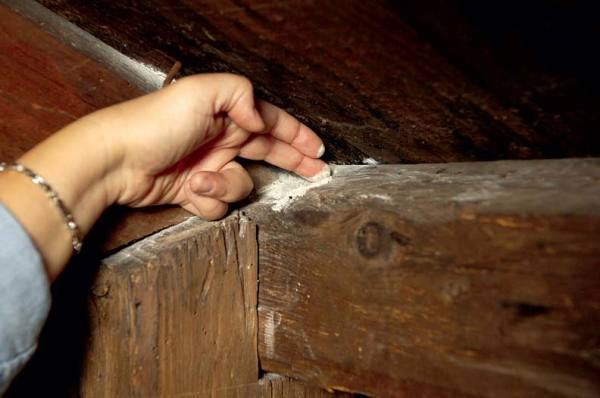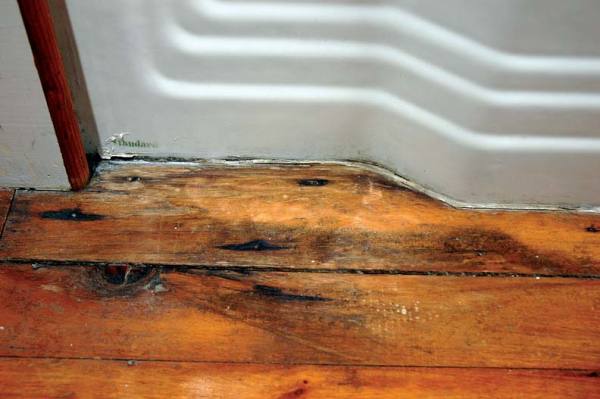Thanks to roof leaks and faulty gutters, a healthy deposit of mildew is thriving at this attic-timber intersection.
Mold helps convert grapes to wine, milk curd to the blue cheese that goes well with wine, and has even contributed to life-saving medical breakthroughs like penicillin. For all the good some mold can do, however, just as many species can cause serious damage. Mold doesn’t discriminate based on the time of year, cleanliness of a house, or, for the most part, geographical location; it’s rare to find a home without any trace of mold. Mold spores—microscopic reproductive “seeds”—can travel inside on people and pets or through windows and doors. They live particularly well in damp or humid areas such as basements, kitchens, and bathrooms, and spread easily throughout the rest of a building.
Mold isn’t a subject to ignore—these organisms present not only health concerns, but also serious risks to vulnerable building materials. Mold can trap moisture and ruin all things wood, and some varieties can even eat through organic materials like paints and finishes. Since old houses tend to harbor the environments that help mold thrive, the more you know about this common household invader, the more able you’ll be to keep it at bay.
What Is Mold?
Molds are microscopic fungi that grow year-round and thrive in any damp, warm, or humid environment. Mildew, which is marked by its strong odor, is technically a species of mold. Mold you can see, usually as black, brown, or green spots, is just the tip of the proverbial iceberg—such visible areas are spore-producing colonies that release millions of airborne particles throughout your house. Some species even have “tentacles” that reach behind the scenes, stretching a dozen feet or more. From basements to bathrooms, kitchens to crawlspaces, it’s impossible to avoid mold completely.
Like any living organism, mold needs the proper environment and nutrients to survive. The most effective way to stem its spread is to eliminate (or limit) the conditions that foster its growth and create an inhospitable environment by removing water infiltration and getting rid of excess moisture in your home.
Removing Mold From Surfaces
Water splashed outside a tub enclosure causes a common mold environment, indicated by black staining on the floorboards.
Moisture creates a prime environment for mold and also destroys wood, finishes, and other building materials by enabling rot. Excess mold growth can add organisms capable of eating wood and other building materials to the mix, and together they can threaten your home’s structural stability. That’s why it’s important to work to reduce excess moisture and eliminate water infiltration into your home.
Excess moisture is often evidenced by surfaces that feel damp, and areas that appear darker than surrounding materials. Water condensation on windows, toilet tanks, or plumbing pipes is another sign of excess moisture trapped in the building. Pay close attention to any plumbing leaks, standing exterior water, or water stains appearing on surfaces, as well as dark green or black spotted areas that indicate the obvious growth of mold. Mildew, a form of mold, grows most commonly as a fuzzy white buildup.
To remove mold from surfaces, use a 1:1 to 1:3 bleach-and-water solution (or a mold-killing cleanser with fungicide) and a good scrub brush. Bleach is the old standby, but it’s not tolerated by everyone. It also strips the color from the mold, making it harder to see. Other fungicides or professional mold remediation companies might be worth considering. When launching serious remediation efforts, regardless of the product chosen, always wear proper protection, including a respirator mask, gloves, and eye protection. Also remember never to mix bleach with ammonia-containing products, as the two can form a toxic gas.
The EPA recommends getting professional help if the mold in your house covers more than 10 square feet, but this isn’t feasible for everybody. Keep in mind that professional mold remediation efforts can include extreme measures like tearing out walls. As a steward of old houses, I always try to save historic fabric wherever possible, and am wary of such tactics. I suggest starting with the measures outlined here to see if you can rectify the problem before considering destroying any original building materials.
How to Keep Mold From Coming Back
Several basic precautions can discourage mold growth in your home:
- During moist, humid months, always run basement dehumidifiers. Empty dehumidifier basins regularly, or have them drain continuously to avoid creating additional hotspots for mold growth.
- In the wintertime, keep humidifiers free from growth by regularly cleaning removable reservoirs. Use a teaspoon to a tablespoon of bleach in the reservoir water and swish it around (or let it set if mold growth is present), then rinse well and fill with fresh water.
- Adequately ventilate your house, and quickly repair any plumbing leaks. Clean surfaces regularly—particularly those in high-moisture areas—with mold-killing products containing fungicide.
- Additionally, it’s not a bad idea to have your furnace ductwork professionally cleaned periodically.
- Make sure any carpets in bathrooms and basements can be lifted out and aired (avoid large rugs or wall-to wall carpeting altogether in these areas), and use vacuum cleaners and air conditioners with HEPA (high efficiency particulate air) filters.
Fans placed strategically in basements, living areas, and attics encourage cross-ventilation and help release heat and humidity. I have small circulating fans permanently operating in my 228-year-old basement to steadily stir the air, and run a dehumidifier year-round. All bathrooms with tubs or showers should have a working exhaust fan. Make sure the fans vent to the outdoors—it’s common to find older exhaust fans blowing moisture out of bathrooms and into kitchens or other areas of the house (attics and basements) where the moisture gets trapped, thus contributing to mold growth.
Warm, dry summer days are a perfect time to give your basement and house a good airing out for the day (but close windows up again before overnight dew accumulates). Proper ventilation of a building is key to letting moisture move through and out so it doesn’t become trapped and begin its path of destruction.
Finally, whenever you’re completing a restoration project, repainting, or exposing older bare wood, always give surfaces a good washing with a fungicide or a 1:1 to 1:3 bleach-and-water solution (followed by a clean water rinse) to kill any existing growth. This quick precaution is well worth it, even if you don’t see any obvious mold growth—if you remove wallpaper and leave any mold growing on underlying plaster, or fail to properly wash woodwork or exterior siding before repainting, mold can eat through your finishing products from the underside and cause all of your hard work to fail.
Contributing Editor Noelle Lord operates Old House C.P.R., Inc. and shares her passion for older buildings through consulting, teaching, and writing.







